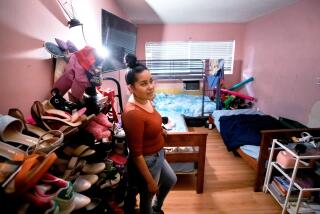Fueling the Trend Toward Own-Your-Own
- Share via
WASHINGTON — The Department of Housing and Urban Development is aiming for a 70% homeownership rate by 2006, a goal some observers believe is unreachable.
To meet the federal government’s newest target, an estimated 3.8 million more families would have to join the ranks of the 70.8 million households who already own the roofs over their heads.
“Is it doable? Yes. But are we going to get there? No,” says David Lereah, the new chief economist at the National Assn. of Realtors.
To boost the ownership rate by 3%--the current ratio was at a record 67.1% at the end of the second quarter--Lereah points out that interest rates have to remain low and the economy must stay strong for six more years. And that, the economist believes, is “extremely doubtful.”
“We’ve already been pretty fortunate over the past six years,” Lereah says. “The goal is certainly worth pursuing, but six more years is a long road.”
Douglas Duncan, Lereah’s counterpart at the Mortgage Bankers Assn., doesn’t think the chances are very good either, explaining that large numbers of households have already become owners earlier than normal because of significantly more favorable loan terms and easier qualifying standards.
“They’re not going to be buying, because they already have,” the MBA economist said. “They may be buying up, but they won’t be adding to the ranks of homeownership. So it’s going to be a stiff challenge.”
HUD admits its objective is a “bold target.” But in a draft of its latest six-year strategic plan, which must be delivered to Congress by Sept. 30, it says the goal can be reached by reducing the ownership gaps between minorities and whites and between lower and higher-income families.
If the ownership gaps between minority and nonminority families and low-income and higher-income households were trimmed 15% and 25%, respectively, HUD says, the 70% target could be reached.
At last count, 73.4% of all white households were homeowners, compared to 47.2% of African Americans and 45.4% of Latinos. Also, the ownership rate in suburbia is 73.8%, compared to 50.7% in central cities, and the rate among households earning less than the median family income is 50.8%. The rate for households with residents under age 35 was 40.5%, with the highest rate, 80.8%, among 55- to 64-year-olds.
HUD’s new plan, which sets the direction for the department’s policies, management and budget resources over the next six fiscal years, promises to reduce the disparities in ownership rates among racial and ethnic groups by earmarking a larger share of FHA-insured loans to minorities, first-time buyers and buyers in central cities.
HUD said it will chase the objective by, in part, increasing the availability and affordability of FHA mortgages and by placing even greater affordable housing requirements on Fannie Mae and Freddie Mac, the two secondary mortgage market companies that channel most of the money for home loans to local lenders.
Other strategies include convening homeownership fairs and recruiting local business, government and nonprofits to help in the effort. Fairs “have proven a valuable tool to increase understanding of the home buying process and to motivate saving for down payments,” the draft report says.
The department also intends to continue promoting new technologies that reduce construction costs and to use grants to support new construction and rehabilitation on a case-by-case basis.
The current target, which was set several years ago, is to achieve a 67.5% ownership rate by the end of this year.
*
Lew Sichelman can be contacted via e-mail at LSichelman@aol.com.
(BEGIN TEXT OF INFOBOX / INFOGRAPHIC)
Homeownership Rates
Although the nation’s overall homeownership rate reached a record high of 68.8% in 1999, young households have actually lost ground. The homeownership rate for people under 35 has dropped 5 percentage points since 1979.
*
Source: “Housing Policy for the 21st Century.”
More to Read
Inside the business of entertainment
The Wide Shot brings you news, analysis and insights on everything from streaming wars to production — and what it all means for the future.
You may occasionally receive promotional content from the Los Angeles Times.










